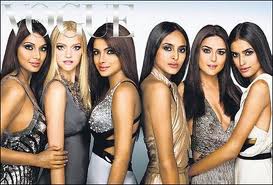A couple days ago, The Fashionomist found an intriguing article (http://fashion.telegraph.co.uk/news-features/TMG8409583/Indias-models-accuse-fashion-industry-of-racism.html) regarding Indian models' accusations of the industry's inherent discriminatory bias against darker-skinned Indians getting premium jobs and pay. Indian society has long held paler skin to high regard - this is, after all, the country that has long held the virtue of fairness equating beauty.
(For proof, please refer to the infamous tube of "Fair & Lovely" [available at your local Indian grocer] and the bevy of Bollywood movie sirens whose paleness does not reflect the average Indian woman's "duskier" complexion.) Beautiful in their own way, the average Indian woman simply does not look like this.
A form of "skinism" is very much alive as a form of quiet discrimination occurring in many an Indian metropolis, where the hue of one's complexion is not only an apparent indicator of beauty, but, much like the racial discriminatory bias unfortunately experienced in American history, affects education, jobs, and income.
With the end of the premier Indian fashion exhibition, Lakme Fashion Week, came an outpouring of criticism from Indian models complaining of skin color bias. Many complained that homegrown productions were giving non-Indian models the best jobs because of their appearance. Who's cashing in? Blue-eyed, blonde/brunette beauties... who just happened to be pale. Yes, Eastern Europeans, Brazilians, and Russians, who admittedly look quite ravishing in ethnic Indian wear... but what's wrong with the run-of-the mill tan Indian woman?
It seems this shade discrimination has reached new heights in recent days after comments made by Indian model Dipannita Sharma, whose fiery tirade has ignited discussion among the Indian fashion elite:
What's the uproar on the shade of skin got to do with economics? Quite a bit. Discrimination is quite possibly the biggest reason for wage disparities in an economy. The marginal productivity theory of income distribution (forgive the minor nerdspeak The Fashionomist is briefly engaging in) aims to explain the wage disparities within industries. Though it isn't exactly a perfectly realistic model (the discussion of which goes beyond the scope of The Fashionomist's little blog here), suffice it to say that it considers difference's in income to be paid equally according to the amount of work a person puts in and the corresponding value of that work. So a model who does equally well in wearing a certain outfit should be getting the same wage as another model. Herein lies the trap though - most industries do not live in utopia. The modeling business, in particular, has been famously racist to the nth degree. The Fashionomist could post a new article everyday regarding charges of racism in the industry.
The fairness/racism issue in fashion is one that is close to The Fashionomist's heart. Beauty is neither the color of one's skin, the color of one's eyes, nor the color of one's hair. As idealistic as this sounds, true beauty lies in the way one carries oneself and their corresponding character. One might argue that in the business of fashion, art is war - the prettiest model fetching the most moolah is the most valuable. But racism has been reduced drastically in most fashion subsectors. Particularly in today's globalized economy, where it is in the fashion house's interest to promote their brand to an international clientele, using multicolored faces is good business.
Modeling is a means by which popular concepts of beauty are conveyed. To promote bleaching one's skin to achieve some misconceived notion of beauty is disgusting, unhealthy, and wrong. The industry itself is getting much more colorful, but India remains a last bastion of fairness worshiping. The Fashinomist sincerely hopes that South Asians can one day (soon) view a woman as beautiful beyond the pigmentation of her dermis.
Perhaps we're moving in the right direction, however - Vogue India has just named Ashika Pratt its supermodel to watch this year. She's photogenic, carries clothes well, and yes, she's coffee-colored and beautiful. Cheers from The Fashionomist for avoiding the easy-peasy route of putting a milky-hued South Asian girl on the cover to try and sell magazines.
*The Fashionomist*



















No comments:
Post a Comment